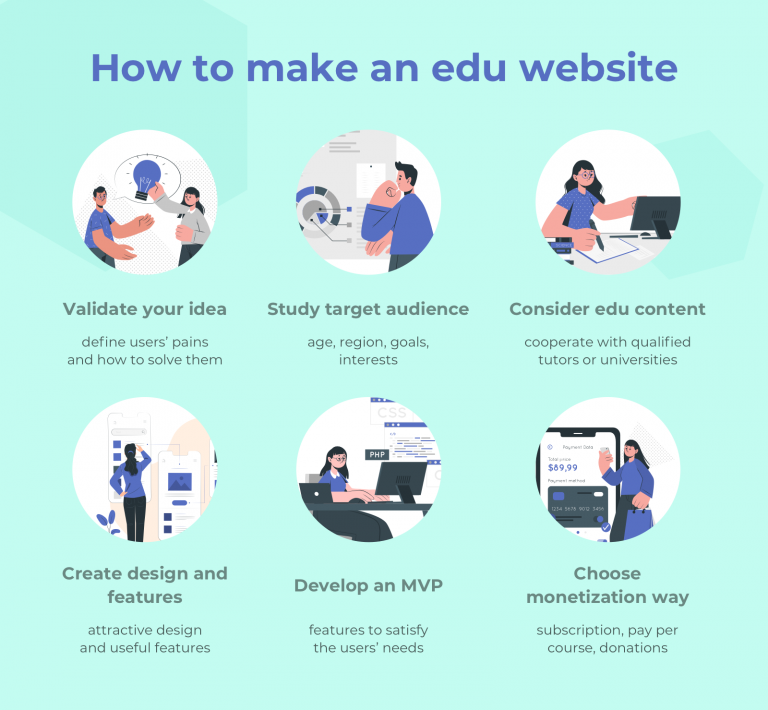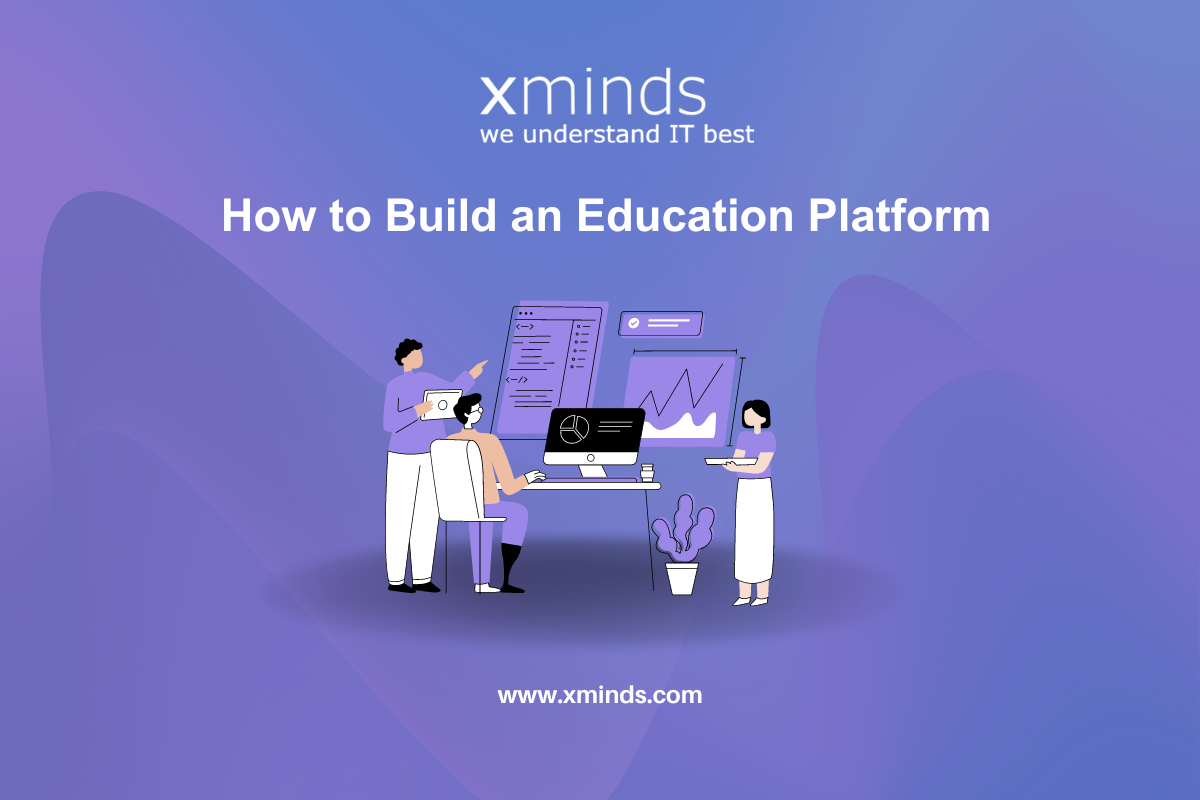How to Design an Educational Website: Types, Features, and Cost

Many users and companies are attracted to online education because of its obvious advantages like better time management and flexibility of learning hours.
Educational website development can make the learning process more exciting and effective by bringing features powered with AR and AI technology.

Online education statistics (Source: EducationData)
Let’s consider the main benefits of online education:
- New opportunitiesStudents can use their mobile devices to interact with content in ways they couldn’t before. It increases their engagement and curiosity without distractions.
- Online education is often less expensive than offlineThere are e-learning platforms, like Udemy, EdX, that provide affordable online courses. Students can start using the service for free and then get premium subscriptions for a reasonable price.
- Online learning is more effective. Students can learn the course material whenever they want and get experiences that match reality.
In this article, we will discuss how to design educational platforms and make money online.
What Are the Different Types of Educational Websites?
Once you’ve decided you want to launch an online course, the next question is: what types of educational websites will suit best for your business. They can be distinguished by learning methods or by the target audience.
Educational Websites by Target Audience
This type of website refers to a specific group of users who will be more likely to use your product. Customers are traditionally divided into:
- High school students (MobyMax, Coursera.org)
- Kids and elementary school (PBS Kids, MathGames, National Geographic Kids)
- Polyglot and Teachers (FluentU, LinguaTrip, Khan Academy)
- Specialists in a particular area (Treehouse, uTest)
 Educational websites by target audience
Educational websites by target audience
Educational Websites by Learning Methods
There are different styles of e-learning methods according to learning tools and content. Some websites offer interactive services, personalized content, or group education.
Computer-Assisted Instruction
Examples: British Council, Coursera
Computers are used to present the instructional material and monitor the learning progress. The system consists of multimedia like audio, videos, that easily explain difficult materials.
Learners are free to experiment with learning options, get immediate feedback, and decide what to learn.
Computer Managed Learning
Examples: Udemy, Alison
CML makes computer software accessible and relevant. Such systems treat every student as an individual and open materials. They usually give you one or two preview videos, so users can check out what they’re going to learn.
Fixed E-Learning
Examples: YouTube, Edx, Tutsplus
It’s common for traditional classrooms, where teachers typically deliver the same content to all students simultaneously (whether they are interested or not). It doesn’t use modern technology’s advantages, like data analytics, to predict student’s desires and give a personalized experience. It’s useful for elementary school, where pupils need to cover every topic.
Adaptive Teaching
Example: Zoomi, Knewton, DreamBox
Research has shown that learning is a highly individual process that depends on knowledge, motivation, and ability. Adaptive tools allow education to be more personalized. Students gain a better understanding and hold engagement within what they are learning.
For example, Knewton  uses data collection to design individual courses.
6 Steps to Start Educational Website Development
Let’s see how to create an educational website and succeed
Step #1. Come Up with a Prospective Idea
Unfortunately, even a great business idea may fail without market support. Start with the decision that is easy to realize, high-demand, and well-paid.
Step #2. Identify Your Ideal Customer
How to deliver the right value to the right user? Analyze your market environment and customers’ expectations. This can include:
- Demographic information
- Hobbies
- How do they like spending their free time
- What social media they prefer
- What problems your product can solve
As a result, you will understand what product will do well and what you need to be held off.
It’s also essential to study competitor weaknesses and make them your strong side. Follow the most popular educational resources to figure out users’ interests and preferences.
Step #3. Fill Up Your Platform With Outstanding Content
It is crucial to provide users with unique content and the latest trends.
For example, Udemy boasts a comprehensive broad course selection with courses covering a different topic: from IT service to nutrition. The instructors are encouraged to update their practices regularly to ensure that they remain relevant.
MasterClass cooperates with famous people, like Michael Kors, Margaret Adwood, Neil Gaiman, to lock customers into their website.
Step #4. Think of Design and Competitive Advantage
If you want to get a lead generation website, it’s essential to think of a high-quality design.
First, write critical ideas for design aspects. Your website should be simple and centered. Talk to UI/UX designers, and they will help to define a clear design strategy.
You need to provide customers with a great experience to convert them into paying customers.
To create an educational platform, you should set tasks for the development team. Here’s a hint:
- Registration Setting
- User profile design
- Interactive Content
- Chatbots
- Calendar
Step #5. Start with an MVP version
MVP or minimum viable product allows you to understand whether your business idea is worth the time and money invested. In case of failure, you won’t lose a lot of money and realize what should be changed.
The MVP makes you figure out the minimum set of features necessary to engage and satisfy primary client’s needs. It helps you attract first users and get priceless feedback about your products.
Step #6. Discover How To Monetize an Educational Website
Ideally, you want to create a learning platform to provide users with valuable information and make a significant income. There are three popular ways how you can earn money from an educational website:
- Subscription Model. Students obtain access to full courses and training programs for a certain fee. For example, Udemy offers a 30-day free trial for some learning materials. The benefits of such methods is a stable revenue. But the number of users will depend on the quality of your information. So, you need to make sure that you’re giving innovative information solutions.
- Pay-per-course. This mode means that students pay for a course that they need for their purposes. Success depends on the relevance of your content.
Donation Buttons. Free high-quality content motivates users to donate to your platform. Once you make an excellent first impression, your website easily attracts new customers.
 Steps to build an educational website
Steps to build an educational website
How Much Does It Cost to Make an Educational Website?
It’s challenging to set up the final price of educational website development. The cost depends on different aspects: project’s size to features you want to implement into your teaching platform.
For example, the , like  Coursera, will be around $60,000, with an average price of $50 per hour.
How long does it take to build an educational platform?
To answer this question, you need to analyze the determining factors:
- Website theme or a custom design
- Total number of website pages
- Actual content
In general, it takes 14 weeks at a minimum to launch an educational website. This includes the discovery phase, design, fundamental development, and editing.
Online education has become a mundane routine for millions of students. Having a learning website is a great way to share your knowledge with people and get extra income.
Author’s bio
Vitaly Kuprenko is a writer for Cleveroad. It’s a web and mobile app development company with headquarters in Ukraine. He enjoys writing about technology and digital marketing.
Related articles



